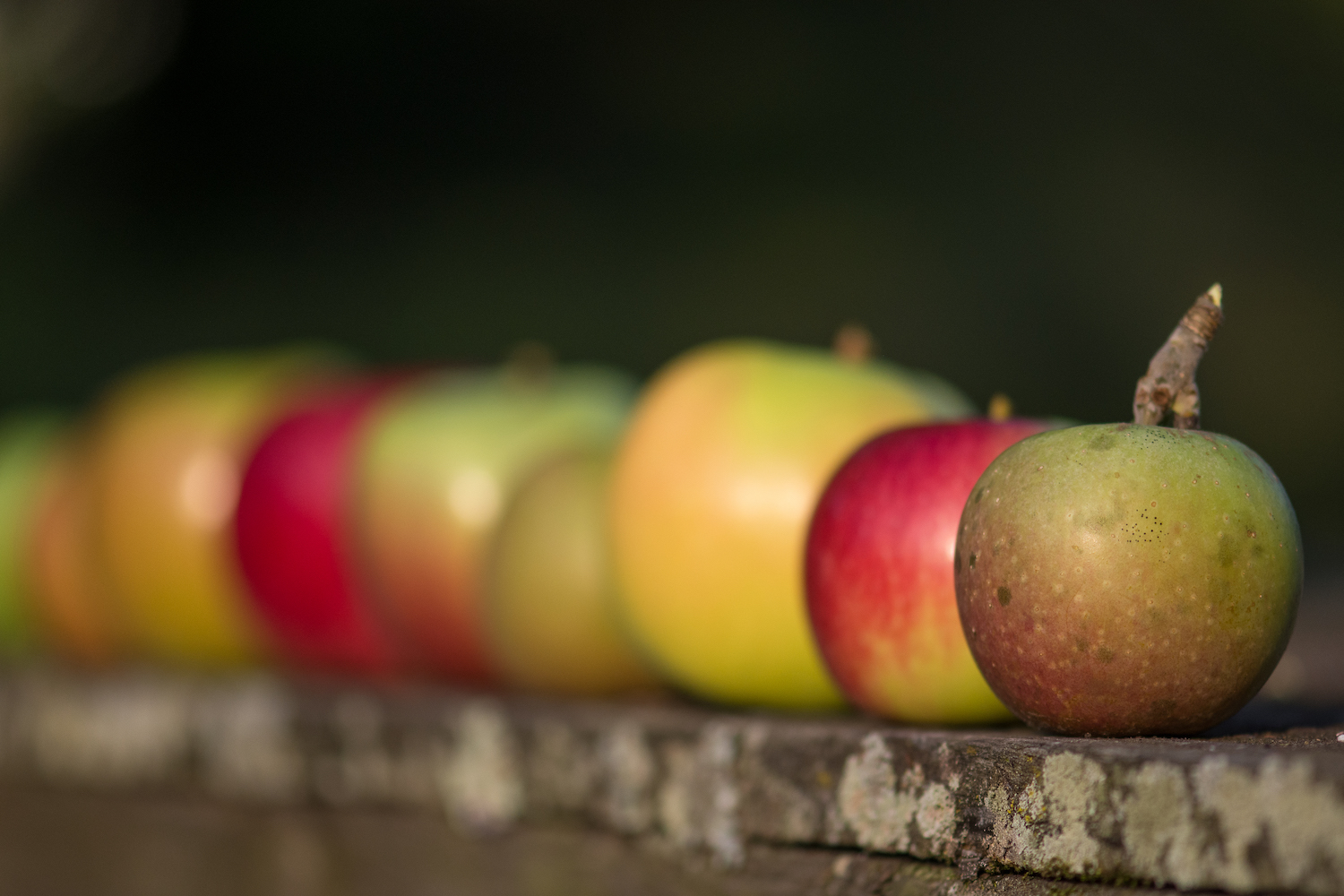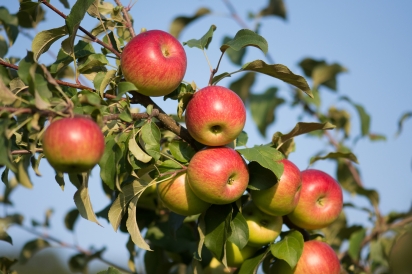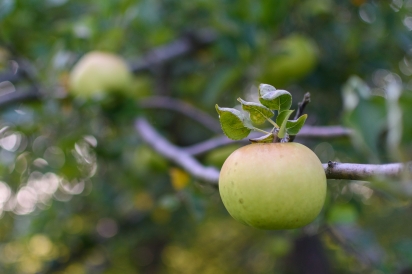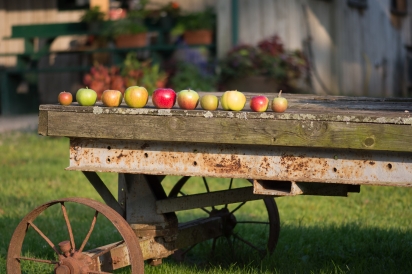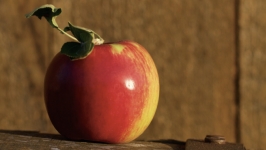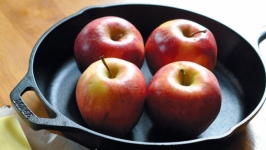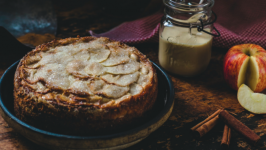Heirloom Apples: An American Tradition
“As American as apple pie,” or so the saying goes. But just how American is the apple? Very. For as the United States is a melting pot of races and ethnicities, so is the apple.
Our apple is the end result of a long geographic journey, drawing on genes from three different species that would eventually set off “an explosion of new varieties” in America, according to Christopher Richards, Population Geneticist at the United States Department of Agriculture (USDA) National Laboratory for Genetic Resources Preservation in Fort Collins, Colorado. Researchers believe that the origins of the modern North American apple began to develop over two million years ago, in what are now western China and Kazakhstan, as Malus sieversii, a large, somewhat sweet apple resembling the modern apple. This apple moved west, likely along the Silk Route, picking up genes around the Black Sea in the Caucasus Mountains and in Northern Turkey from Malus orientales, a small apple with complex bitter or sweet-sour flavors. It then acquired more genetic characteristics in Western Europe from Malus sylvestris, a tart crabapple. These three species contributed to the hybrid Malus x domestica, comprising many diverse varieties across Europe.
Grafting technology may have helped the apple travel from east to west, considering that techniques of grafting fruit trees were in use in Ancient Mesopotamia at least by the first millennium B.C.E., according to Ken Mudge, et al. The ethnic populations who settled in America would have brought cuttings (known as “scion wood”) from their favorite varieties of Malus x domestica for grafting onto fruit trees. They also would have brought apple seeds and seedlings, all genetically unique, which cross-pollinated with the multiplicity of domesticated European varieties and, perhaps, also with the indigenous wild North American Malus species, which were of service to Native Americans. In addition, some cultivars were intentionally introduced here for their desirable characteristics, such as Russian varieties for their hardiness. Overall, this additional hybridization, enhanced by movement into the American melting pot, gave us the many varieties of Malus x domestica that we know today.
By definition, an heirloom is a prized possession handed down through generations. An heirloom apple is a variety that can be traced back at least 50 to 100 years. Each brings its own history, bearing curious names, such as “Newtown Pippin” [circa early 18th century, hailing from Newtown (now Elmhurst), New York, in Queens], “Summer Rambo” (from the 16th-century French variety “Rambour d’été”), or “Esopus Spitzenberg” (originating around 1790 in Esopus, New York, and which is said to have been Thomas Jefferson's favorite). Names may vary in different regions for the same genetic cultivar. Heirloom apple trees can reach more than 100 years of age and are very tall, “giants,” according to Patrick Horan of Waldingfield Farm, in Washington, Connecticut, who grows several heirloom varieties, including a Russian one, “Duchess of Oldenburg.” American heirloom apple trees are often some 30 feet or taller, whereas current commercial apple trees are usually kept much smaller for easier harvesting.
Before the modern industrial era, all apples were what we now call “heirloom,” a recent term. Estimates vary as to how many heirloom apple varieties there once were, given that open-source pollination allows for any number of combinations that may be produced from seed. However, experts agree that there once were thousands of varieties. “There’s a reason they’re heirlooms,” says Gary Keough, USDA State Statistician for New England States, referencing market forces that make it more profitable for growers to use the modern varieties. Even though the flavor of some heirlooms, like “Sheep’s Nose,” may improve during storage, other heirloom varieties do not keep as well, are not as pretty, have an irregular shape, or are more susceptible to disease, as opposed to commercial cultivars, which are carefully bred for certain characteristics, such as shape, crispness, color, or storage potential.
In contrast to the diversity of heirlooms, today’s supermarkets offer, at best, only a dozen commercial apple varieties, of which Red Delicious and Gala are the most consumed. Commercial apples succeed partly because of their predictability: huge orchards of the same few varieties produce the reliable apples that consumers have come to recognize. However, the genetic traits of these homogeneous commercial apples are, in a sense, “inbred,” and so more restricted. Although the enormous genetic variation of historic heirloom apples is no longer available to consumers, thousands of viable DNA samples still exist at national germplasm repositories, such as the one in Fort Collins. These heirloom seeds are valuable as a genetic safeguard, should new agricultural problems arise, due, for example, to invasive insects or climate change. As Keough explains, “You never know when those older traits may be needed.” Currently, there are burgeoning national and grassroots movements to save and distribute heirloom seeds.
The heirlooms have a voice with a knowledgeable purveyor of apple lore, Peter Montgomery, of Montgomery Gardens in Warren, who enjoys exploring the genealogy of his apples, as well as telling the story of their influences and effects. For example, not only are the Rambo apples of centuries-old French lineage, but they are the inspiration behind the name of novelist David Morell’s protagonist in First Blood, eventually lending their name to the Sylvester Stallone character in the Rambo film franchise. This, all because Morell’s wife had brought home some heirloom Rambos from a farm stand.
An all-around apple enthusiast, Montgomery gives hands-on advice about reviving and cultivating heirloom apple trees. With about 40 heirloom apple trees of his own, last year, Montgomery planted an heirloom orchard of 10 apple varieties at the Eric Sloane Museum in Kent and, this fall, plans to install an heirloom apple orchard at the Tapping Reeve House and Law School in Litchfield, site of the oldest law school in the United States (built in 1784, after Reeve had been teaching law for 10 years). The Tapping Reeve orchard will have a dozen heirloom trees, including Summer Rambo, Jonathan, Wealthy, Roxbury Russet, Baldwin, and Pound Sweet, which originated in Manchester, Connecticut, around 1834 and is also known as “Pumpkin Sweeting” and “Yankee Apple.” According to Tom Burford, Pound Sweet once provided apple butter for armies on both sides of the American Civil War.
Many of the roughly 50 Connecticut commercial orchards also grow heirloom apples but do not always market them as such. For instance, Lyman Orchards in Middlefield still maintains some Baldwin heirloom apple trees that are over 100 years old. Blue Hills Orchard in Wallingford grows and sells Opalescent heirloom apples at its Country Store. A good pie apple dating to the 1880s, these Opalescents used to be a stock ingredient at the Frisbie Pie Company of Bridgeport (in production 1871-1956, recently restarted, and whose round pie tin contributed to the genesis of the famous Frisbee toy). Now cultivating about 75,000 apple trees, Blue Hills Orchard was founded in 1904 by William Henry, great-great-grandfather of Eric Henry, present owner with his wife, Rebecca. Long established, a Wallingford native reminisces about how the Henry’s truck would come around on Saturdays in the 1930s to pick up teenagers waiting on Wallingford street corners to help with harvesting. More recently, Blue Hills Orchard has planted 100 new heirloom apple trees, including Herefordshire Redstreak, with a pedigree dating to the early 1600s, and Dabinett, both bittersweet apples sought after for making hard cider.
Also boasting both heirloom and commercial apple cultivars, Hickory Hill Orchards in Cheshire grows 23 varieties in over 2,000 individual trees, of which about 100 are heirloom, including Northern Spy, Winesap, Stayman-Winesap, and Roxbury Russet, which is considered the first apple to have been named in North America (in the early to mid-1600s, in Roxbury, Massachusetts). According to new manager Charles Beasley, who is leasing Hickory Hill from owner Fred Kudish, Northern Spy heirlooms are an unusual “tip bearing” variety, with apples appearing only on new vertical growth. Beasley prunes Northern Spies with great care, trimming only part of the new growth, since the following year’s buds grow on those vertical shoots. Beasley explained that he also thins out other branches closer to the tree’s central leader, not just to reduce the number of insects, but also to allow sun and wind for the tree to thrive. He expects a good apple crop this year, since the heavy spring rains have increased their size so far this season, what growers call “sizing well.” Some old-time New Englanders rave about the Northern Spy being the best apple for pie.
Apple culture has enhanced and even ensured our survival, encompassing far more than pies. As water was not always safe, early European settlers produced not only fresh-pressed cider, which had a short shelf life in an era before refrigeration, but by necessity, also hard cider, whose alcohol content allowed for long-term storage. Historian W. J. Rorabaugh estimates that, in 1710, the drinking age population (over age 15) in the American colonies consumed 34 gallons annually of hard cider (containing 10% absolute alcohol), but that by 1835, this was down to 15 gallons annually per person of drinking age. After 1840, even less hard cider was consumed, while beer grew in popularity. Hard cider is once again developing a following, strengthened by new interest in cultivating heirloom apples with their special characteristics of taste and texture.
For example, New England Cider Company in Wallingford uses both heirloom and commercial apples from local orchards in making its hard cider. Certain heirlooms, like the Golden Russet, may not have the smooth texture of the “fresh-eating” commercial varieties, but according to Miguel Galarraga, cidery co-owner with Seth Hart, the Golden Russet is desirable for hard cider due to its high sugar content, which offers the potential for a higher percentage of alcohol during fermentation. Other heirlooms are prized for their abundant tannins, which yield a more acidic, tangy flavor. Some connoisseurs also believe that the thick skin of the older heirloom apples delivers fuller flavor for cider than the thinner skin of newer commercial varieties.
Heirloom apples, long valued for their genetic diversity and range of flavor, are ripe for a comeback. Heirloom varieties offer a hedge against severe weather that might devastate an entire genetically identical crop of our modern commercial varieties, and Connecticut’s overgrown fields and woods may hide some of these long-lived heirloom treasures. Why, you may have a prized jewel growing right in your own backyard. Apple pie never had it so good.
To plan a trip to Connecticut’s apple orchards, consult the Connecticut Department of Agriculture website, which lists nearly 70 apple growers in our state, or visit the Connecticut Orchards Directory, compiled by Orange Pippin, Ltd., where pomological aficionados can search for specific varieties of fruit in our region.


